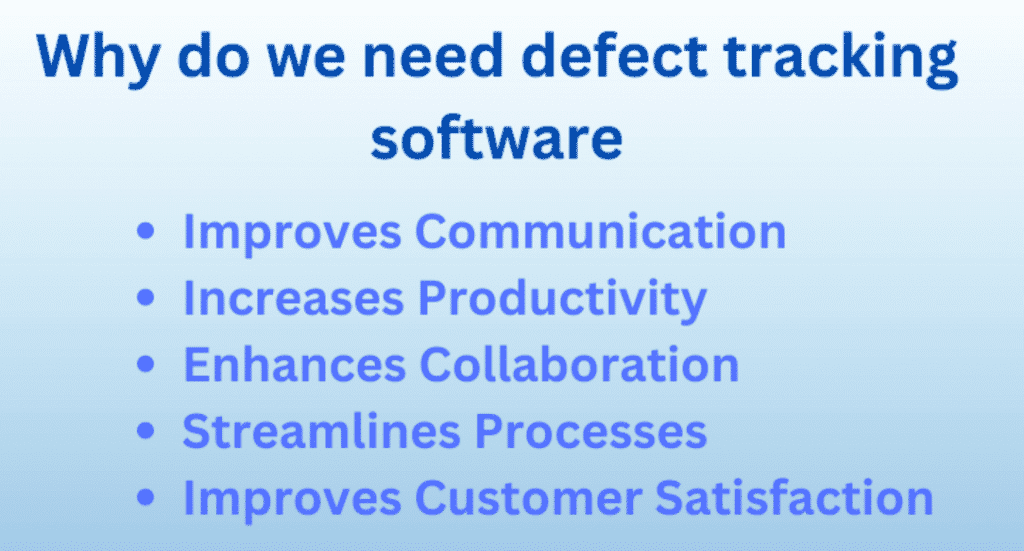Defect tracking software, also known as bug tracking software, is a type of software application that helps teams to manage and track defects, issues, and bugs in their software products. These tools provide a centralized platform for teams to report, track, and manage issues throughout the software development lifecycle.
Defect tracking software serves as a vital component in the software development process, aiding teams in maintaining a systematic record of bugs and issues that arise during the various stages of product development. These tools streamline collaboration, enabling team members to coordinate efficiently and ensure that problems are swiftly identified and resolved. With features for categorizing, prioritizing, and tracking issues, these applications are instrumental in maintaining the quality and integrity of the final product.
Here are some of the reasons why we need defect tracking software:

- Improves Communication: Such a software can improve communication between team members by providing a central platform for reporting and tracking defects. This makes sure that everyone in the team is aware of the problems and their status.
- Increases Productivity: By tracking defects and issues, teams can identify areas of the software that require improvement, which can lead to increased productivity and better quality software.
- Enhances Collaboration: Collaboration is improved because defect tracking software enables team members to communicate and solve problems collectively. This makes it easier to make sure that everyone is on the same page and striving for the same thing.
- Streamlines Processes: With a defect tracking software, teams can streamline their processes by automating tasks such as issue assignment, notification, and status updates.
- Improves Customer Satisfaction: Defect tracking software can help to identify and resolve issues before they are reported by customers, leading to higher customer satisfaction.
Defect tracking software is a tool that allows developers and quality assurance (QA) teams to manage defects, bugs, and other issues that arise during the software development life cycle. We’ll walk through setting up and putting defect tracking software into practice in this blog.
Identify Your Needs
Before selecting a defect tracking software, it is essential to identify the specific needs of your organization. Some important questions to ask yourself include:
- What sort of software do you build?
- How big is your development team?
- What is your software budget plan?
- What services does the software need to have?
- What kind of assistance and instruction do you need?
When you have the answers to these inquiries, you’ll be able to focus your search and choose the software that best suits your requirements.
Research Defect Tracking Software Options
There are many defect tracking software options available, ranging from free and open-source software to paid solutions. Some popular options include:
Research each option thoroughly to determine which one best meets your needs. Look at user reviews, feature lists, and pricing to compare each option. It is also essential to consider the type of software development methodology your organization uses, such as Agile, Waterfall, or DevOps, as some defect tracking software may be better suited to specific methodologies.
Set Up the Defect Tracking Software
Once you’ve selected a defect tracking software, it’s time to set it up. This could entail employing a cloud-based solution or downloading and installing the programme on your server. Some software may also require the installation of additional plugins or integrations with other tools.
During the setup process, it is crucial to ensure that the software is configured correctly and meets your organization’s needs. This may involve setting up workflows, custom fields, and permissions. It is also important to train your team on how to use the software and ensure that everyone understands the processes and workflows that will be used.
Implement the Defect Tracking Software
Now that the software is set up, it’s time to start using it. Begin by creating a project and adding the necessary information, such as project name, description, and team members. Next, create a list of tasks, issues, and bugs that need to be addressed, and add them to the software. Assign tasks to team members and set deadlines to ensure that work is completed on time.
It is essential to routinely assess the program during the implementation phase and make any necessary modifications. This may involve updating workflows, creating new custom fields, or adding new integrations with other tools. Regularly reviewing the software will help ensure that it continues to meet the needs of your organization as it grows and changes.
Collaboration
It can be a powerful tool for promoting collaboration among team members, both within the development team and between the development and QA teams.
By using the software to track defects and assign tasks, team members can work together more effectively, sharing knowledge and expertise to resolve issues more quickly. Collaboration can also help to ensure that issues are resolved correctly and thoroughly, reducing the likelihood of similar issues occurring in the future. To promote collaboration, it is important to ensure that team members have access to the software and are trained on how to use it effectively. It may also be helpful to establish clear communication channels and encourage team members to share their ideas and perspectives openly.
Overall, promoting collaboration through the use of such a software can help to improve the quality of your software and enhance the overall efficiency and effectiveness of your development team.
Monitor and Improve
Defect tracking software is not a set-it-and-forget-it solution. It is essential to regularly monitor the software and make improvements as needed. This could entail changing workflows, adding new features, or giving team members further training.
Regularly monitoring and improving the software will help ensure that your organization continues to get the most value from the software and that it remains a valuable tool for managing defects and improving the quality of your software.
Conclusion
In conclusion, setting up and implementing defect tracking software is an essential step for any organization that develops software. By identifying your needs, researching software options, setting up and implementing the software, and regularly monitoring and improving it, you can ensure that your organization is equipped with a powerful tool for managing defects and improving the quality of your software.
Selecting the appropriate defect management tool is fundamental for efficient software development processes. Such a tool streamlines defect detection, allowing swift assessment and rectification. When issues are promptly identified and addressed, it significantly reduces the time and resources spent on fixing defects later in the development cycle, thereby enhancing overall productivity.
Moreover, recognizing and handling defects during the development phase is an integral aspect of quality control in any software development project. This proactive approach not only ensures that the final product meets the necessary quality standards but also minimizes the chances of defects causing delays or disruptions during later stages of the development process. This diligent defect management process guarantees a more efficient and smoother software development lifecycle.


























